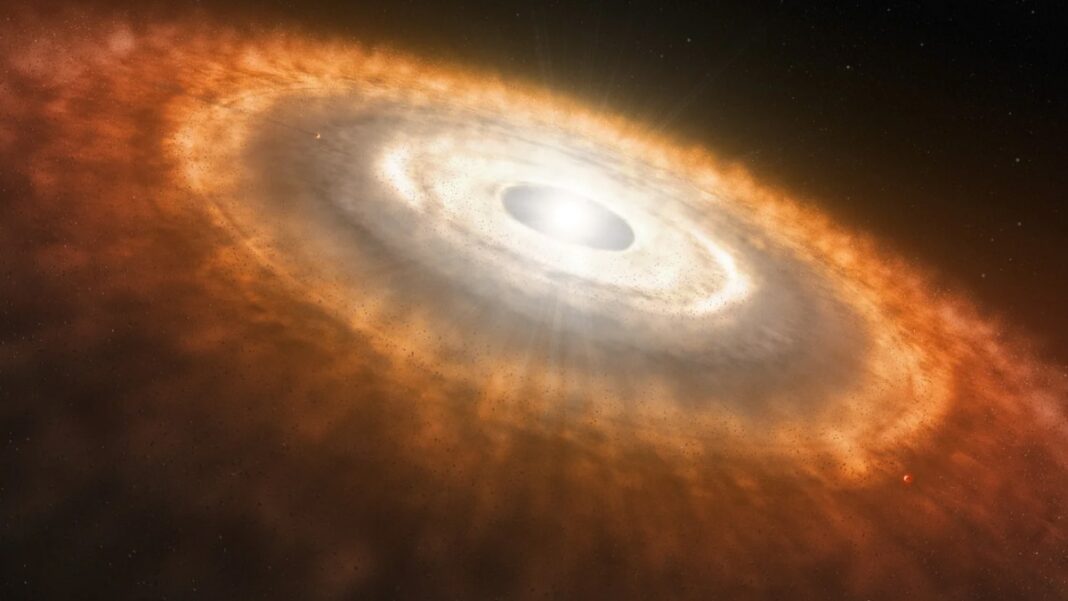PDS 70b: A New Perspective on Exoplanet Formation
In the vast expanse of the universe, a remarkable discovery has stirred the foundations of planetary science. PDS 70b, a nascent exoplanet located in the constellation Centaurus, has challenged our understanding of how planets come into being. Recent research, published in Astrophysical Journal Letters, unveils a profound mismatch between the composition of PDS 70b’s atmosphere and the materials of its birthplace, the protoplanetary disk. This revelation has sparked a reevaluation of established theories surrounding the formation of celestial bodies.
PDS 70b’s Unique Characteristics
PDS 70b, one half of a sibling system, dwarfs Jupiter in size and gracefully orbits its stellar parent at a distance akin to Uranus in our own solar system. Astronomers estimate that this planetary prodigy has been assembling cosmic fragments for approximately 5 million years, nearing the culmination of its formation saga. Utilizing the powerful Keck II telescope in Hawaii, researchers scrutinized the planet’s atmosphere for telltale signs of carbon monoxide and water, unraveling insights into its elemental origins.
Discrepancy in Chemical Composition
The crux of the matter lies in PDS 70b’s atmospheric constitution, which defies conventional expectations by exhibiting a marked deficiency in carbon and oxygen content. Dr. Chih-Chun Hsu, a visionary postdoctoral researcher at Northwestern University leading the charge, posits that this anomaly exposes potential oversights in prevailing planetary formation models.
Theories Behind the Unexpected Results
In a bid to make sense of this cosmic conundrum, scientists offer two compelling conjectures. One hypothesis suggests that PDS 70b assimilated a significant portion of its carbon and oxygen from solid precursors like ice and dust, liberating these vital elements during evaporation before amalgamation. Dr. Jason Wang, a distinguished co-author of the study and assistant professor at Northwestern University, elucidates that this transformative process could dramatically alter the planet’s carbon-to-oxygen ratio. Alternatively, it is postulated that the protoplanetary disk underwent recent carbon enrichment, a scenario endorsed by select formation paradigms.
Future observations of PDS 70c, the sibling planet in this binary system, hold the promise of further unraveling the enigmas surrounding planetary genesis. Scientists underscore the imperative of exploring similar celestial systems to glean broader insights into the intricate mechanisms governing planet formation.
Conclusion
The cosmic ballet of PDS 70b unveils a mesmerizing spectacle that challenges our preconceptions of planetary birth. As we delve deeper into the mysteries of the universe, each celestial revelation propels us towards a more profound understanding of our cosmic origins.
Frequently Asked Questions
- What makes PDS 70b’s discovery significant?
- The discovery of PDS 70b challenges existing theories of planet formation, urging a reevaluation of our understanding of celestial birth.
- How did researchers study PDS 70b’s atmosphere?
- Scientists employed the Keck II telescope in Hawaii to analyze the planet’s atmospheric composition for key elements like carbon and oxygen.
- What are the implications of PDS 70b’s unique characteristics?
- The anomaly in PDS 70b’s chemical composition sheds light on potential oversights in current planetary formation models.
- What are the proposed theories to explain PDS 70b’s unexpected results?
- Researchers suggest that the planet either assimilated carbon and oxygen from solid sources or that the protoplanetary disk underwent recent carbon enrichment.
- Why is studying PDS 70c important for understanding planetary formation?
- Observations of PDS 70c can provide additional data to refine our comprehension of planetary formation processes.
- What insights can studying systems like PDS 70b offer?
- Exploring similar celestial systems can offer broader insights into the intricate mechanisms governing planet formation.
- How does PDS 70b’s size compare to Jupiter?
- PDS 70b is nearly three times the size of Jupiter, making it a colossal entity in the cosmic tapestry.
- What role does the protoplanetary disk play in planet formation?
- The protoplanetary disk serves as the cosmic cradle from which planets like PDS 70b emerge, influencing their elemental composition.
- How long has PDS 70b been accumulating material for its formation?
- PDS 70b has been gathering cosmic debris for approximately 5 million years, nearing the culmination of its formative journey.
- Why is the discrepancy in PDS 70b’s chemical composition significant for planetary science?
- The discrepancy challenges established notions of how planets accumulate mass and elements during their formative stages, prompting a reevaluation of planetary formation models.
Tags: PDS 70b, exoplanet, planet formation, celestial bodies, planetary science, cosmic origins.
- The discrepancy challenges established notions of how planets accumulate mass and elements during their formative stages, prompting a reevaluation of planetary formation models.

